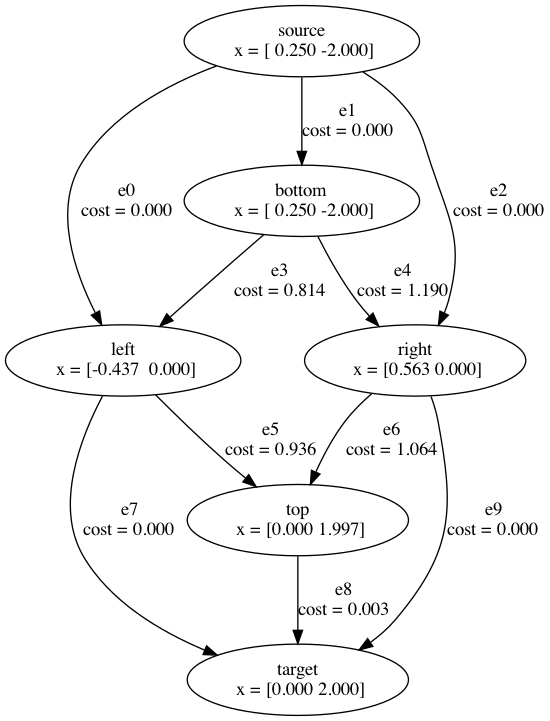Discrete + continuous optimization

MIT 6.821: Underactuated Robotics
Spring 2023, Lecture 17
Follow live at https://slides.com/d/Yp1UjL4/live
(or later at https://slides.com/russtedrake/spring24-lec17)

Image credit: Boston Dynamics
Running example: Shortest path around an obstacle

start
goal


- Combinatorial (e.g. over homotopy classes)
- Smooth optimization (over curves)
Two aspects of the motion planning problem:

start
goal
Motion planning as a (nonconvex) optimization

start
goal
fixed number of samples
collision-avoidance
(outside the \(L^1\) ball)
nonconvex
Planning as a mixed-integer convex program

goal
start
disjunctive
constraints
Mixed-integer programs
"Convex relaxation" replaces this with:
"Mixed-integer convex" iff \(f\) and \(g\) are convex.
Convex relaxation is "tight" when the relaxed solution is a solution to the original problem.
Branch and bound
Convex relaxations provide lower bounds
Feasible solutions provide upper bounds
convex
convex
convex
convex
convex
Branch and bound performance
- Number of integer variables
- "Tightness" of the convex relaxation
- Motion planning transcription:
\(\Rightarrow\) Long solve times.
- Too many integer variables (false combinatorial complexity)
- Disjunctive programming leads to "loose" relaxations
Traditional Shortest Path as a Linear Program (LP)
\(\varphi_{ij} = 1\) if the edge \((i,j)\) in shortest path, otherwise \(\varphi_{ij} = 0.\)
\(c_{ij} \) is the (constant) length of edge \((i,j).\)

"flow constraints"
binary relaxation
path length
Graphs of Convex Sets


-
For each \(i \in V:\)
- Compact convex set \(X_i \subset \R^d\)
- A point \(x_i \in X_i \)
- Edge length given by a convex function \[ \ell(x_i, x_j) \]
Note: The blue regions are not obstacles.
New shortest path formulation
Classic shortest path LP
now w/ Convex Sets
New shortest path formulation
Non-negative scaling of a convex set is still convex (e.g. via "perspective functions")
Achieved orders of magnitude speedups.
Randomized rounding
convex
Motion planning with Graph of Convex Sets (GCS)

start
goal

Motion planning with Graph of Convex Sets (GCS)
This is the convex relaxation
(it is tight!).
is the convex relaxation. (it's tight!)


Previous formulations were intractable; would have required \( 6.25 \times 10^6\) binaries.
- When sets \( X_i \) are points, reduces to standard LP formulation of the shortest path (known to be tight).
- There are instances of this problem that are NP-hard.
- We give simple examples where relaxation is not tight.
- Can add (piecewise-affine) dynamic constraints on pairs \( (x_i,x_j). \)
Remarks
Ex: Minimum-time double integrator


Example: "Footstep planning" with \(x_{n+1}=Ax_n + Bu_n\)

| Previous best formulations | New formulation | |
|---|---|---|
| Lower Bound (from convex relaxation) |
7% of MICP | 80% of MICP |

Dynamic planning through contact

Planning through contact for Planar Pushing
Planning through contact for general manipulation
